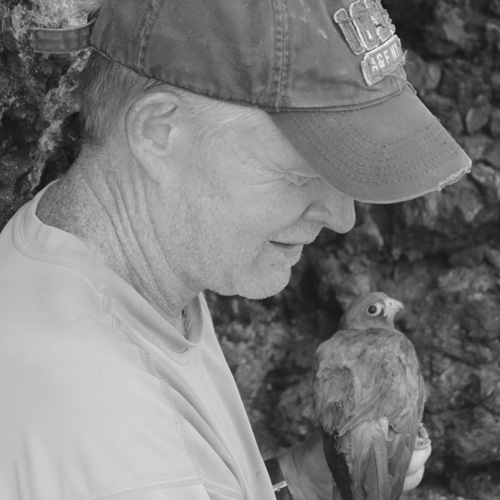
Länge: 60 Minuten | Drehzeit: Juni 2015 bis Juli 2016 | Schnitt: Juli 2016 bis Januar 2017 | Vertonung: Englisch, Arabisch, Deutsch und Französisch | Untertitel: Englisch | Produzenten: Henning Schwarze und Khalid al Toubi | Auftraggeber: Diwan of Royal Court, Office for Conservation of the Environment, Oman | OCE-Projekt Manager: Dr. Mansoor Hamed Al Jahdhami | Kamera: Robin Jähne | Regie und Schnitt: Robin Jähne und Sarah Herbort

Geheimnisvolle Wüstenflieger
“Schieferfalken im Oman” ist der Titel dieses faszinierenden Dokumentarfilms über die Bemühungen des Sultanat Oman, diese bedrohte Falkenart zu studieren und zu schützen. Das Filmteam begleitet die Falken und die omanischen Wissenschaftler während der Brutzeit in ihrem Lebensraum auf abgelegenen Inseln in Oman. Und wir folgen der Route der jungen Falken, überqueren die Al Hajar Berge und die Rub Al Khali-Wüste, verweilen kurze Zeit am Horn von Afrika und erreichen schließlich Madagaskar, das Überwinterungsgebiet der Schieferfalken.
Den Schieferfalken auf der Spur
Der Bestand der Schieferfalken geht weltweit zurück. Das staatliche Büro für den Schutz der Umwelt im Sultanat Oman, OCE, startete zusammen mit internationalen Experten ein Forschungsprogramm mit dem Ziel, mehr über diesen einzigartigen Greifvogel zu lernen und den Bestand zu schützen. Ein Deutsch-Omanisches Naturfilmteam begleitete die Arbeiten der Wissenschaftler und erlebte dabei hautnah den Lebenszyklus des scheuen Falken. Durch den Einsatz neuartiger Kameratechnik entstand so eine einzigartige und faszinierende Naturdokumentation.
The Daymaniyat Archipelago, islands with rough cliffs, around 20 kilometers off the coast of Oman – A camera rests in a small, stony cave on a cliff. A female Sooty Falcon arrives to feed its chicks. Earlier, they were sitting on the camera and hurried their mother along. These shots are transmitted over a 300-meter distance to a niche in the rocks on the beach. Here, a sun shade provides needed protection for the movie team at temperatures of around 50 degrees celsius. Nature filmmaker Robin Jähne remotely swivels the camera behind the arriving female. “Here, we use a specially-designed remote-control technology,“ explained the German cameraman. “Because a camouflaged hide that is free of disturbances is not possible at the falcon cave on the cliff. In this way, we can take absolutely authentic images from a few centimeters away, without disturbing the natural behavior of the falcon.”
“Robin Jähne and his colleague, Sarah Herbort, were a team that had already been distinguished numerous times internationally for their nature films and that we were able to engage,“ explained producer Henning Schwarze (INTEWO). Schwarze, also from Germany, has worked together in the past for several years with the nature filmmakers. He, together with his Omani colleague Khalid al Toubi, form the production team, which is responsible for the project.
Henning Schwarze is a geographer, media expert and entrepreneur with international experience. “This film represents an extensive, international project– with shooting in Oman, Ethiopia and Madagascar. The film has been produced in four languages and is arguably the most comprehensive and unique documentary on the Sooty Falcon and its habitat.“
The background: the latest studies show that the world’s population of Sooty Falcons (Falco concolor) is diminishing greatly. One tenth of these birds breed on islands and cliffs of the Sultanate of Oman, in the eastern part of the Arabian Peninsula. Reason enough for the OCE scientists to institute an international research project. Among others, the goal was to develop measures to protect this unique bird of prey.
“The film shows the wildlife and nature through the flacon eye, and the various landmarks during his long journey. The Sultanate of Oman is an important habitat for the falcon in a sensitive period in its lifecycle”, commented Dr. Mansoor bin Hamad Al Jahdhami, OCE Project Manager.
“The movie follows the work of the researchers. Above all, however, it is a nature documentary that displays not only the life of the Sooty Falcon, but rather also its integration into the environment,“ explained Henning Schwarze. Among breathtaking landscapes, the fascinating coral reefs that surround the Daymaniyat Islands on which the falcons are breeding are also a part of the story. Cameraman Robin Jähne’s equipment therefore includes the appropriate diving equipment in order to also capture the underwater world – the food source for many animals on the island. The falcons themselves feed on migrating oscine birds. When the prey’s migration is over, the falcons then fly to their winter quarters. The Omani scientists outfitted some falcons with GPS transmitters and were thus able to follow their migration on the Arabian Peninsula, which first leads over rugged mountains and the Rub Al Khali, the great sand desert, and finally extends across East Africa to Madagascar. The Sooty Falcon enjoys rich feeding there in winter – with migratory locusts finding themselves primarily on the menu.
The film team followed the falcons on their travels, stopped in Ethiopia at the Lake Tana UNESCO Biosphere Reserve, and finally reached Madagascar, with filming in the world famous “Avenue of the Baobas”. “We are lucky to have been able to capture some images that have never been filmed in that way,“ said Robin Jähne. One example is a time lapse of the view of a Sooty Falcon from the crown of a massive baobab tree on the west coast of Madagascar.
It is always fascinating to see how close the audience apparently is to the animal protagonists, including during feeding. “When the falcons go so far as to sit on the camera in the process, this becomes our greatest compliment – it actually shows that our technique does not disturb the birds and the camera is accepted as part of the surroundings,“ according to the filmmakers. But there can also be times when the young birds toss the camera over, but this then becomes an interesting scene in the movie.
Bester Dokumentarfilm
Der Film “Schieferfalken im Oman” wurde beim Muscat International Film Festival 2018 als bester Dokumentarfilm ausgezeichnet.
Bonus Features
Offizieller Trailer
Jagdszenen auf Jazeera Dymaniat
Gewitter in Madagascar
Team
Ein hochmotiviertes Team, widerstandsfähig gegen Hitze, Staub, Luftfeuchtigkeit und Insekten
Credits
Adlerwarte Detmold, Dr. Alexandra Laube, Dr. Alyia Al Ansari, Andrew Lawrence, Asad Al Wahaibi, Ashoka Bandara, Dr. Benno Böer, Bernhard Walter, Dimby Harrison, Dirk Grote, Dr. Fareed Krupp, Fikirte Demissie, Gayan Perera, Gilbert Razafimanjato, Gulf Jewels Travels & Tours, Hans Christian Freiherr von Reibnitz, Jaafar Al Toubi, Jamal Al-Sulaimi, Kuriftu Resort & SPA, Dr. Lily Arison Rene de Roland, Mare Addis, Ministry of Environment and Climate Affairs Oman, Mitslal Kifleyesus-Matschie, OCE Administration and Finance Staff, Dr. Oliver Krüger, Oman Air, Peter Blank, Royal Oman Police, Royal Yachts at Royal Court Affairs, Said Al Musharfi, Sailor Said Juma Al Syiabi, Sami Muktha, Sultan Qaboos University, Tanalahorizon, The Peregrine Fund Madagascar Project, Thorsten Negro, UNESCO Office Addis Ababa

Copyright © 2023 Sooty Falcon Movie | All rights reserved by INTEWO & OCE | Legal notice | Data Protection Declaration
In memory of Simon Aspinall











